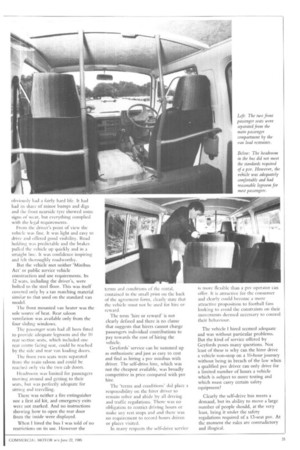A CHARTER FOR
Page 36

Page 37

If you've noticed an error in this article please click here to report it so we can fix it.
SOCCER HOOLIGANS?
Tougher laws to ban alcohol on coaches travelling to soccer matches could mean less hooliganism, but at the moment there is an easy way round them. Simply hire a self-drive minibus. This is just what sober, non-soccer fan Noel Millier did
COACI--1 operators often feel aggrieved about 'unfair' competition from self-drive hire companies offering 12 to 15-seat nonpsv minibuses. Some also think that self-drive minibuses will give soccer hooligans a chance to travel to away fixtures and drink alcohol on the way to the match.
The fears of operators are easy to understand, although some cynics would accuse them of being motivated by selfinterest rather than public safety.
To find out whether self-drive minibuses provide a value-for-money service to the public and if they pose a threat to safety I hired a bus and discovered just what it offered It took three inquiries to find a company willing to supply at short notice what was quoted as a 12-seat minibus. The daily rate o140 allowed unlimited mileage, but with insurance and collision damage waiver this increased to S:51.60.
Fuel was not included although any fuel left in the vehicle by the previous biter was not charged for.
The hire company was Geyfords Car Rental of Wallington in Surrey and the minibus was a Nissan Urvan. Service was friendly and helpful. I was told that the 'levels' on the vehicle had been checked and given a run-down on the controls. There was some minor body damage on all sides of the A-registration vehicle and I was told these had been noted before I took the bus away.
Outside, the vehicle was clean, but inside, the floor in the rear was a little grubby. A previous hirer had spilt something sticky on the plastic floor covering.
The appearance inside was greatly enhanced by moquette seat coverings, but it was immediately apparent that the vehicle was not built to the comfort standards required of a public service vehicle.
After collecting the vehicle F checked it over and found all levels correct, and all lights, wipers and washers were working correctly. Mileage on the clock was 21,500 and the little bus had obviously had a fairly hard life. It had had its share of minor bumps and digs and tin front nearside tyre showed some signs of wear, but everything complied with the legal requirements.
From the driver's point of view the vehicle was fine. It was light and easy to drive and offered good visibility. Road holding was predictable and the brakes pulled the vehicle up quickly and in a straight line. It was confidence inspiring and felt thoroughly roadworthy.
But the vehicle' met neither 'Minibus Act' or public service vehicle construction and use requirements. its 12 seats, including the driver's, were bolted to the steel floor. This was itself covered only by a tan matching material similar to that used on the standard van model.
The front mounted van heater was the sole source of heat. Rear saloon ventilation was available only from the four sliding windows.
The passenger seats had all been fitted to provide adequate legroom and the 10 rear section seats, which included one rear centre facing seat, could be reached by the side and rear van loading doors.
The front two seats were separated from the main saloon and could be reached only via the two cab doors.
Headroom was limited for passengers moving around and getting to their seats, but was perfectly adequate for sitting and travelling.
There was neither a fire extinguisher nor a first aid kit, and emergency exits were not marked. And no instructions showing how to open the rear door from the inside were displayed.
When I hired the bus I was told of no restrictions on its use. However the
terms and conditions of the rental, contained in the small print On the back of the agreement form, clearly state that the vehicle must not be used for hire or reward.
The term 'hire or reward' is not clearly defined and there is no clause that suggests that hirers cannot charge passengers individual contributions to pay towards the cost of hiring the vehicle.
C;eyfords' service can be summed up as enthusiastic and just as easy to cost and find as hiring a psv minibus with driver. The self-drive hire, which was not the cheapest available, was broadly competitive in price compared with psv hire.
The 'terms and conditions' did place a responsibility on the hirer driver to remain sober and abide by all driving and traffic regulations. There was no obligation to restrict driving hours or make any rest stops and and there was no requirement to record hours driven or places visited.
In many respects the self-drive service
is more flexible than a psv operator can offer. It is attractive for the consumer and clearly could become a more attractive proposition to football fans looking to avoid the constraints on their movements deemed necessary to control their behaviour.
The vehicle I hired seemed adequate and was without particular problems. But the kind of service offered by Geyfords poses many questions. Not least of these is why can the hirer drive a vehicle non-stop on a 10-hour journey without being in breach of the law when a qualified psv driver can only drive for a limited number of hours a vehicle which is subject to more testing and which must carry certain safety equipment?
Clearly the self-drive bus meets a demand, but its ability to move a large number of people should, at the very least, bring it under the safety regulations required of a 12-seat psv. At the moment the rules are contradictory and illogical.




































































































